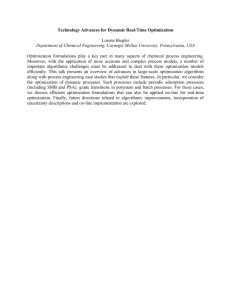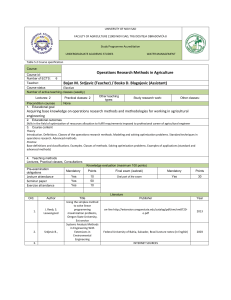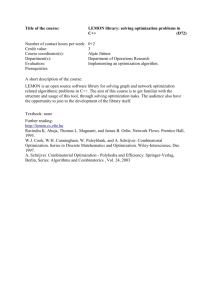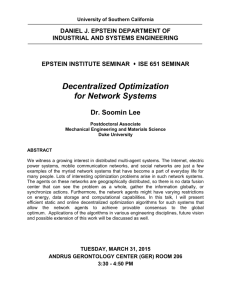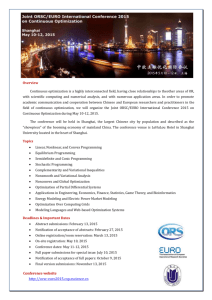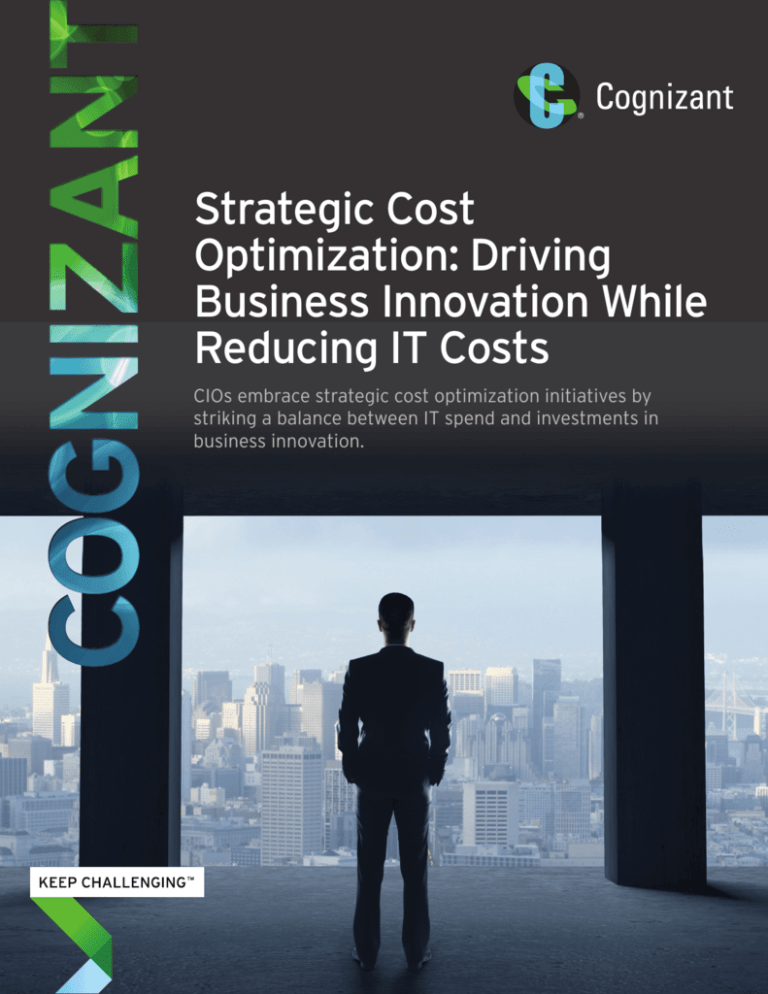
Strategic Cost
Optimization: Driving
Business Innovation While
Reducing IT Costs
CIOs embrace strategic cost optimization initiatives by
striking a balance between IT spend and investments in
business innovation.
Executive Summary
Faced with ongoing business uncertainty and never-ending
pressure to optimize IT spend, CIOs are shifting away from
pure cost reduction programs and embracing more strategic
cost-saving initiatives. Strategic cost optimization techniques
prepare organizations for growth by striking the right balance
between reduced IT spend as a percentage of revenue and
increased investments in business innovation and IT improvement
initiatives. Thus, many CIOs are turning to strategic IT cost
optimization (ITCO) programs that support a business mandate
to simultaneously innovate and build long-term competitive
advantage while reducing technology-related costs.
This white paper weighs the benefits and downsides of shortterm cost reduction vs. strategic cost optimization programs
and offers a four-level framework for prioritizing initiatives that
enable IT to better support the business, both today and for the
future. It provides a framework that can help CIOs prioritize cost
optimization initiatives by considering not only the potential
cost savings, but also other benefits, such as time requirements,
degree of organizational and technical risk, impact on customers
and investment required.
2
KEEP CHALLENGING
March 2014
STRATEGIC COST OPTIMIZATION: DRIVING BUSINESS INNOVATION WHILE REDUCING IT COSTS
3
Short-term Cost Reduction vs. Strategic
IT Cost Optimization
Decision-makers often resort to cost-cutting measures in response to business
pressures to reduce IT spend. However, by focusing on short-term cost-cutting
within organizational siloes and without the context of the business strategy and
technology roadmap, these initiatives often result in higher IT costs in the long term
and, in some cases, are abandoned altogether. Figure 1 compares the outcomes of
short-term cost-cutting initiatives with a more forward-looking strategic cost optimization program focused on organizational health.
Strategic IT optimization initiatives require upfront investments and are conducted
within the context of the business and IT strategy. While a long-term perspective on
cost-cutting is important, short-term reductions are achievable through the identification of quick wins that are less disruptive to the business (e.g., software license
reductions, application consolidation and retiring applications).
As time progresses, organizations begin to realize the benefits of these investments
and cost-saving initiatives. The savings that result can then be directed to bottomline spend reductions, or some portion can be reinvested in subsequent optimization initiatives, depending on the current and future strategic needs of the business.
Large upfront investments that are needed to drive lower unit costs are often counterproductive due to:
• Unpredictable business requirements and IT demands (e.g., fluctuating economic,
sector and industry conditions).
Cost Reduction vs. Cost Optimization
IT spend reductions
from enhanced agility
and efficiency.
Fractional reinvestment
of IT savings.
Time
Figure 1
4
KEEP CHALLENGING
Cost increases
due to strategic
misalignment,
lack of scale,
rework, etc.
IT Costs ($)
Capital Investment in IT Initiatives ($)
Short-term impact
of cost saving
initiatives.
March 2014
Time
• Potential business exit/divestiture.
• Short-term opportunities or projects that are inconsistent with the long-term
business direction.
• Rapid new business/growth opportunities that require frequent IT changes and
expensive scaling.
Software as a service (SaaS) and other services delivered via the cloud may appear
to be more expensive initially, but they may often provide improved long-term
returns. This is because of the operational and financial flexibility that these initiatives afford, such as consumption-based pricing that variablizes cost outlays.
Thus, a strategic IT cost optimization program is not a one-time initiative. Instead,
it is a continuous improvement exercise for CIOs seeking to optimize IT spend and
deliver a sustainable business advantage. However, CIOs can no longer concentrate
resources and investments on cost reduction efforts alone; they must maintain an
appropriate balance between meeting savings targets and supporting necessary
innovation and process improvements that future-proof the business.
Four Levels of Strategic Cost Optimization
Figure 2 illustrates how an organization can transform its cost optimization efforts
from tactical to strategic and realize maximum value over a specific period of
time. Our framework helps CIOs and other decision-makers weigh the risk-reward
tradeoffs of all possible initiatives before implementing them.
Transform to
higher levels
Tighter alignment
with business
Do more with less
2
3
4
Transform: Invest more to optimize more
Agenda: Evaluate technology, broaden capabilities,
create new sources of revenue.
Rationalize: Business relevance, flexibility, agility
Agenda: Rationalize IT portfolio, reduce functional redundancies.
Optimize: Remove waste, increase efficiency
Agenda: Improve processes, “go lean,” evaluate target operating
models (shared services), exercise sourcing options.
1
Low
Cost Savings
High
A Framework for Strategic Cost Optimization
Reduce: Reduce costs and prioritize spend
Agenda: Cut IT costs, prioritize demand, span of control enhancements .
Tactical
Nature of IT Cost Optimization
Strategic
Figure 2
STRATEGIC COST OPTIMIZATION: DRIVING BUSINESS INNOVATION WHILE REDUCING IT COSTS
5
Here is a closer look at each level within the strategic cost optimization framework:
• Level 1 (Reduce): Cut costs and prioritize spend.
Companies tend to prioritize cost optimization initiatives by simply considering short-term cash savings. While cash savings are important, prioritizing costoptimization initiatives with only short-term goals in mind can cause unanticipated problems. Decision-makers must consider the degree of organizational
and technical risk, as well as the impact of such myopic thinking on consumers
of IT services.
• Level 2 (Optimize): Remove waste and increase efficiency.
Cost-cutting can have unforeseen negative consequences. The focus should be
on eliminating excess waste while increasing the efficiency of current systems.
Speed-to-market, quality and utilization have become exceedingly important.
Suitable metrics to measure performance should be implemented, such as
speed of IT delivery (i.e., development and implementation time), reduction in
transaction time for users and integration of valuable IT assets. Such metrics
can indicate the efficiency level of IT initiatives across all areas of the organization.
• Level 3 (Rationalize): Seek business relevance, flexibility and agility.
It is imperative to focus on business goals and ensure that IT initiatives are
aligned with business objectives and priorities. IT performance metrics should
be closely tied to business metrics so that their alignment can be measured
appropriately. Some of the metrics that could help with the measurement of
an organization’s business innovation include addition of new customers/users,
ability to meet current and future functional needs and reduction in time to
market of new products and services.
• Level 4 (Transform): Invest more to optimize more.
As economic conditions improve, companies can focus their cost optimization
efforts on implementing long-term business and IT process improvements,
enabling business growth and innovation, and repositioning the business to
sustain a competitive advantage. As the percentage of IT investment aimed
at business transformation increases, the percentage spent on business
sustenance should remain constant or decline as operational efficiencies are
achieved over time.
IT Cost Optimization Planning
Recognizing that cost optimization teams usually operate on tight timeframes, we
have created a framework for prioritizing cost optimization techniques by considering not only the potential benefits in terms of savings, but also the time requirements, degree of organizational and technical risks, impact on customers, and
investment required.
By evaluating the factors depicted in Figure 3 (see next page), CIOs can weigh
the future strategic value, risks and benefits of cost optimization initiatives. In
assessing options, decision-makers should also take into account:
• Time to complete the initiative.
• Tactical and organizational risk.
• Upfront cash investments required to achieve downstream savings.
6
KEEP CHALLENGING
March 2014
Prioritizing IT Cost Optimization
Score
Dimension
1
2
3
Strategic Value
Low
Medium
High
IT Control
Low
Medium
High
Potential Cost and
Benefit
Low
Medium
High
Customer Impact
Negative
Neutral
Positive
Time to Benefit
Realization
< 18 months
6 — 18 months
< 6 months
Degree of
Business Risk
Degree of
Technical Risk
• Reengineering of current
• Limited changes in
• Minimal organizational
• Impact on operating system,
• Moderate impact on few
• Minor impact on technical
processes and organizational
structures. Staff redundancies.
database and middleware.
roles and organizational
structures.
technical components.
change and staff impact.
components.
Likelihood of
Reprioritization
and Cancellation
High
Medium
Low
Investment
Requirement
High
Medium
Low
9
18
22
27
Total Score
Reject
Evaluate
Accept
Figure 3
Even after using our framework, some opportunities may not be addressable due to
various constraints, such as time to completion. Thus, it is a good idea to group and
map initiatives in a grid to develop an implementation timeline.
Three-Step Approach to Strategic IT Cost
Optimization
We follow a three-step approach that tailors IT cost optimization to organizationspecific optimization goals. Figure 4 highlights the key components of our IT cost
optimization framework.
STRATEGIC COST OPTIMIZATION: DRIVING BUSINESS INNOVATION WHILE REDUCING IT COSTS
7
IT Cost Optimization: Three-Step Approach
IT Investment Optimization
IT &
Business
Alignment
Flat or declining IT budgets, coupled with an increased demand for IT services.
Remova
Remo
vall of exp
xpen
ense
sess fr
from
om cur
urre
rent
nt spe
pend
nd or ru
run
n ra
rate
te in or
orde
derr to inv
nves
estt in fut
utur
ure
e
business opportunities.
Defi
fine IT investment
t
t
opti
op
timi
miza
zati
tion
on goa
oals
ls
Identi
Id
tiffy investtmentt
oppo
op
port
rtun
unit
ity
y
Priioriti
itize investtmentt
port
po
rtfo
foli
lio
o
Devellop
p ongo
g ing
g
gove
go
vern
rnan
ance
ce
IT Cost Assessment
Opportunity
Identification
Business challenges identified through merger, acquisition or divestiture
of business operation.
Increased utilization of IT resources and assets.
Alternate
sourcing
Software
Business
alignment
Vendor
renegotiation
Hosting
Consolidation/
rationalization
Network
Standardization
End User
Computing
People
alignment
IT Overhead
Management
Application portfolio rationalization
Realization
of Benefits
Infrastructure rationalization
Organization and operating model
Global sourcing
Operations and process transformation
Figure 4
Our methodology assesses a core set of key organizational objectives (i.e., total
cost savings, impact on customers, time requirements, degree of organizational
and technical risk and required investment) for various IT cost optimization initiatives. When planned strategically, these objectives can result in a variety of benefits
to IT organizations (see Figure 5).
Looking Forward
Business uncertainty will continue to impact IT organizations, and even a wellthought-out cost savings program can prove ineffective in the long run. However,
when cost pressures are intense, businesses must overcome the dual challenge of
continuously innovating while reducing spend to outperform the competition.
Overcoming these obstacles requires a strategic cost optimization program to
strike a balance between cost reduction initiatives and investments needed to
generate process efficiencies, improve quality of service, build a stronger value
chain, improve skill management and increase customer satisfaction. Further, cost
optimization cannot be a one-time strategic IT initiative. Instead, it should be a
guiding principle for managing IT in the most efficient manner while responding
promptly to fluctuations in business conditions.
8
KEEP CHALLENGING
March 2014
IT Cost Optimization Initiative Benefits
ITCO
Initiatives
Cognizant’s Approach
Portfolio Assessment
Application
Portfolio
Rationalization
the portfolio based on business and technology
• Assess
drivers.
a cluster analysis to select the group of
• Conduct
applications to be rationalized.
a portability analysis to check how easily the
• Conduct
portfolio can be migrated to target architecture.
Transformation Plan Definition
Improved Cost Management
• Reduce/contain costs without affecting service quality.
• Continuous IT spend optimization.
Increased Efficiency
• Highly flexible IT portfolio.
analysis of system deficiencies, process
• Improve
constraints and risks from technology architecture
perspective.
• Define the plan to achieve the target architecture.
• Prepare the transformation roadmap.
Business Transformation
Asset Optimization
Cost Efficiencies
• Infrastructure standardization
• Desktop virtualization
• Printer fleet optimization
Infrastructure
Rationalization
Benefits
Contract Optimization
vendor and maintenance contract
• Procurement
negotiations.
Overall Service Model
• Adapt to industry best practices.
• Seamless business transformation flow.
• Reduce total cost of ownership.
• Reduce procurement and support service cost.
Increased Efficiency
economies of scale by standardization of
• Improve
assets.
operational efficiency by aligning to industry
• Obtain
standards and investing in more optimization initiatives.
• Patch management.
• Help desk support.
• OS upgrade.
• Security updates.
IT Performance and Process Improvement
Increased Cost Savings
IT Workforce and Skills Optimization
Improved Product Quality and Service
• Maturity assessment.
• Process improvement roadmap.
Organization
and Operating
Model
•
•
•
Workforce assessment and strategy.
Suitability analysis.
Governance and change management.
Increased Customer Satisfaction
organization flexibility to respond to business
• Increased
demand.
Needs Assessment
Strategic Advantage
Current organization assessment.
Future organization definition.
Governance and transition recommendations.
• Identify strategic goals and baseline inventory.
Suitability Analysis
• Portfolio maturity analysis.
• Service model definition.
Operations
and Process
Transformation
time to market by combining improved
• Improve
schedules with higher quality.
IT Organization and Governance Model
•
•
•
Global Sourcing
due to process standardization and reduced
• Savings
re-work.
Transition Planning & Financial Analysis
competitive edge by investing IT cost savings
• Achieve
into more forward-looking innovative ideas.
Cost Savings
cost for acquiring skills with prompt response to
• Reduce
ramp-up and ramp-down situations.
• Resource planning.
• Financial analysis.
• Sourcing strategy.
Improved Skills Management
Supplier Selection
• Supplier selection, evaluation and finalization.
Long-term, Trusted Relationships
Enterprise & Business Transformation Functions
Stronger Value Chain
• Leverage the best skills wherever they exist.
high-valued workforce for more important
• Dedicated
initiatives.
• Co-development, benefit and risk sharing
• Transformation driver identification.
• Improve visibility of end-to-end value chain.
• Current state assessment of capabilities, operating model • Strengthen supplier and partner relationship.
and IT portfolio.
Improved Demand Management
• Future state operating model definition, IT roadmap,
• Increase demand forecast accuracy.
sourcing model, architecture roadmap and governance
•
framework.
Transformation adoption roadmap.
Improved Cost Management
• Drive significant increase in bottom line.
Figure 5
STRATEGIC COST OPTIMIZATION: DRIVING BUSINESS INNOVATION WHILE REDUCING IT COSTS
9
Quick Take
Lighting Up IT
A leading electric utilities company in the U.S. engaged us
to help the organization embrace a robust IT cost optimization methodology. The company’s goals were to achieve
significant cost savings across infrastructure, process and
technology through:
Tools
• Reduced
• 20% reduction in overlapping tools.
technology total cost of ownership and
improved ROI.
• Effective sourcing of technology resources.
• Process and operations maturity.
• Tool rationalization and end-state planning.
We engaged with various business stakeholders within
the organization to optimize and consolidate organization-wide processes through self-optimization and
varied levels of sourcing approaches. We established
clear service and operational level agreements (SLA and
OLA) and used service automation to enable productivity improvements. The team rationalized the utility’s
infrastructure, application and tools costs, implemented
enterprise monitoring standards and enabled end-to-end
tools integration. Lastly, we implemented ITIL component
capacity management (CCM) and SACM processes,
including IT asset management.
tion.
• $3.4M in labor savings through end-to-end integration
and automation.
Technology
• $9M estimated savings via technology optimization.
• Reduction in Op-Ex (i.e., vendor support and software
costs) by as much as 20% in full-time staff supporting
network operations.
• Approximately 15% to 20% cost savings in 85% of virtualized environments.
Process
• Improved cost-capacity balance.
• Improved system availability and productivity against
capacity issues.
• Cost avoidance on duplication of tools, data sources
and processes.
Effective Demand Management
Key benefits of the IT cost optimization framework
program included:
• Establishment of an effective demand/forecast process
Cost savings
Better Skill Management
• $5M labor savings via self-optimization.
• $9M average labor savings per year
tion and improve focus on strategic activities.
via selective
sourcing.
• $14M to $19M average labor savings per year via full
sourcing over a span of five years.
KEEP CHALLENGING
March 2014
for capacity.
• Cross-training of resources to enhance resource utiliza­
People
10
• $1.6M software license savings as a result of consolida-
• Selective use of third parties for low-skilled activities
and gradual increase of offshore resources.
Better Product Quality
• Improvement in client’s perception of quality.
• Robust SLAs and OLAs across the organization.
• Reduced time to solution of complex issues/problems.
About the Authors
Harold Albo is a Director in Cognizant Business Consulting’s Strategic Services
Practice. With over 25 years of professional experience, Harold’s strategic consulting
expertise spans IT transformation projects, application portfolio analysis, and IT
service management and governance. He has deep experience in IT performance
and cost optimization. Harold holds a bachelor’s degree from North Carolina State
University and an M.B.A. from the University of South Carolina. He can be reached
at Harold.AlboJr@cognizant.com.
Shreshth Anand is a Senior Consultant in Cognizant Business Consulting’s Strategic
Services Practice. With six-plus years of IT consulting experience, Shreshth’s
expertise spans IT process management, organization change management and
performance management. He holds a bachelor’s degree from Visvesvaraya
National Institute of Technology and an M.B.A. from the Asian Institute of
Management, Manila. Shreshth can be reached at Shreshth.Anand@cognizant.com.
Manga Rajesh Gali is a Senior Consultant in Cognizant Business Consulting’s
Strategic Services Practice. He has more than eight years of IT advisory experience
spanning IT strategy and transformation, organization change management, IT
cost optimization and global sourcing strategy. Rajesh holds a bachelor’s degree
from Indian School of Mines and an M.B.A. from XLRI Jamshedpur, India. He can be
reached at Mangarajesh.Gali@cognizant.com.
STRATEGIC COST OPTIMIZATION: DRIVING BUSINESS INNOVATION WHILE REDUCING IT COSTS
11
About Cognizant
Cognizant (NASDAQ: CTSH) is a leading provider of
information technology, consulting, and business
process outsourcing services, dedicated to helping the world’s leading companies build stronger
businesses. Headquartered in Teaneck, New Jersey (U.S.), Cognizant combines a passion for client
satisfaction, technology innovation, deep industry
and business process expertise, and a global, collaborative workforce that embodies the future of
work. With over 50 delivery centers worldwide and
approximately 171,400 employees as of December 31, 2013, Cognizant is a member of the NASDAQ-100, the S&P 500, the Forbes Global 2000,
and the Fortune 500 and is ranked among the
top performing and fastest growing companies in
the world. Visit us online at www.cognizant.com
or follow us on Twitter: Cognizant.
World Headquarters
500 Frank W. Burr Blvd.
Teaneck, NJ 07666 USA
Phone: +1 201 801 0233
Fax: +1 201 801 0243
Toll Free: +1 888 937 3277
inquiry@cognizant.com
European Headquarters
1 Kingdom Street
Paddington Central
London W2 6BD
Phone: +44 (0) 207 297 7600
Fax: +44 (0) 207 121 0102
infouk@cognizant.com
India Operations Headquarters
#5/535, Old Mahabalipuram Road
Okkiyam Pettai, Thoraipakkam
Chennai, 600 096 India
Phone: +91 (0) 44 4209 6000
Fax: +91 (0) 44 4209 6060
inquiryindia@cognizant.com
© Copyright 2014, Cognizant. All rights reserved. No part of this document may be reproduced, stored in a retrieval system, transmitted in any form or by any means,
electronic, mechanical, photocopying, recording, or otherwise, without the express written permission from Cognizant. The information contained herein is subject to
change without notice. All other trademarks mentioned herein are the property of their respective owners.

